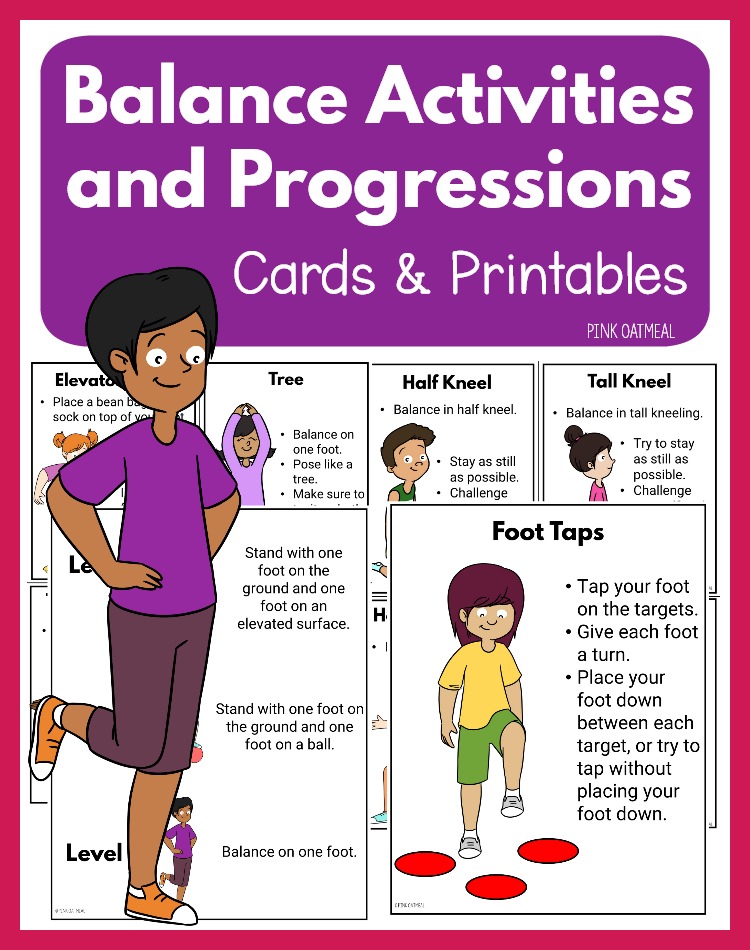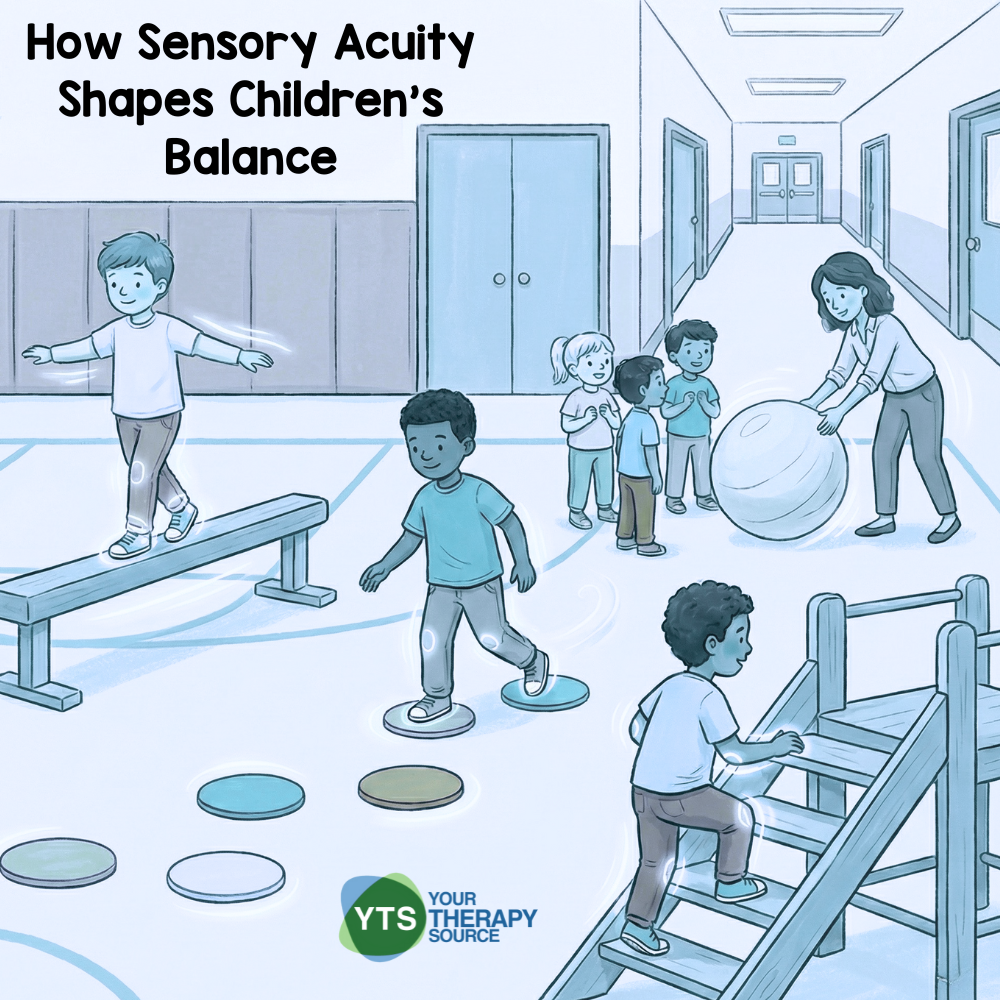How Sensory Acuity Shapes Children’s Balance
Children use many senses to stay balanced as they sit, move, and play throughout the day. A new study explored how two specific skills, proprioception and visual motion detection, might contribute to a child’s ability to stay steady, especially during movement. The results help us understand why some children seem stable while standing still but struggle once they start walking, climbing, or navigating busy environments. Learn more about this research study to determine how sensory acuity shapes children’s balance.

Understanding Sensory Acuity
Sensory acuity refers to how clearly and accurately the brain receives and interprets sensory information. Higher sensory acuity means the child’s brain is getting more accurate input to guide posture, movement, and balance. In this study, researchers examined:
- Proprioceptive acuity: how well a child senses the position and movement of their body without relying on vision
- Visual motion detection acuity: how well a child sees and interprets movement in the environment
What Is Proprioception?
Proprioception is the body’s internal positioning system. It helps children know:
- where their limbs are
- how much force to use
- how to adjust their posture
- how to make automatic corrections when they start to lose balance
Children with weaker proprioception might seem uncoordinated, bump into objects, lean excessively, or have difficulty with activities that involve stopping, starting, or changing direction.
What Is Visual Motion Detection?
Visual motion detection helps children see:
- how their bodies are moving
- how the environment around them is moving
- how close or far objects or people are
- when they need to adjust their speed or direction
A child who has trouble detecting motion accurately might bump into peers, misjudge spacing in lines, or struggle on the playground.

Balance Exercises for Kids
Static Balance vs. Dynamic Balance
Static balance is the ability to stay steady while standing still. Dynamic balance is the ability to stay steady while moving.
- Examples of static balance: standing in line, standing on a firm surface
- Examples of dynamic balance: walking in a busy hallway, climbing stairs, stepping over obstacles, playing tag
The study found that sensory acuity might be more closely related to dynamic balance, not static balance. In other words, sensory skills may matter most when children are in motion, not when standing still.
What We Can Learn From This Study on Sensory Acuity and Balance
This study offers helpful insights into why some children appear steady when standing still yet struggle once movement is involved. These results may help educators, therapists, and parents better understand how sensory processing might influence a child’s balance in real-world settings. Results from this study may not apply the same way to every child, but they can offer a useful framework for understanding movement and balance.
- Dynamic balance depends on sensory processing: dynamic balance, not static balance, may require children to constantly interpret proprioceptive and visual motion information. A child who stands still without difficulty might still struggle during movement in hallways or on the playground.
- Clumsiness may reflect sensory effort: children who trip, bump into others, or avoid movement might be working hard to process sensory input, not acting carelessly. These findings might explain why some children do well in still positions but have challenges once movement is involved.
- Proprioception and visual motion detection matter: the study found links between sensory acuity and dynamic balance performance, which may indicate that accurate sensory information supports smoother movement. Children with different sensory profiles might show different responses.
- Static balance may not reveal sensory challenges: standing still on a force plate did not correlate with sensory acuity. This might be because static balance relies less on continuous sensory updates. Some children might appear balanced in still positions while still having difficulty with movement.
- Younger children sway more naturally: increased sway in younger children might reflect normal development rather than a concern. Age-related changes may happen at different rates for each child.
- Movement-rich classroom routines help: activities such as hallway obstacle courses, heel-to-toe walking, “mirror me” exercises, and stepping-stone paths might help support whole-body sensory processing and dynamic balance.
- Therapy should include real-world movement: pediatric OTs and PTs may consider using tasks that involve weight shifting, uneven surfaces, moving targets, and visually guided movement. These approaches might help children who rely heavily on sensory feedback.
- Simple home activities build balance: games like follow-the-leader, hopscotch, chalk-line walking, catching bubbles, climbing, and jumping between tiles may help children explore movement safely. These activities might support proprioception and visual motion awareness in everyday play.
- Movement experiences support development: children may develop stronger balance skills through repeated opportunities for safe, full-body movement. While many children benefit, each will respond differently based on their individual sensory and motor needs.

Balance Games Interactive PDF
Sensory Supports for Students Who Struggle With Sensory Acuity and Balance
These study results may help guide practical decisions about how to support children who find movement-based tasks challenging. Some students might have difficulty staying steady during transitions, navigating hallways, or participating in physical activities because their sensory systems are working harder to interpret body position or movement. The following supports may help, and each child may respond differently depending on their individual sensory and motor profiles.
- Proprioceptive supports
heavy-work breaks such as carrying books or pushing carts, weighted lap pads, wobble cushions, resistance bands on chair legs, footprint markers, and brief movement activities before transitions may improve body awareness and grounding. - Visual motion supports
preferential seating away from busy areas, slower modeled demonstrations, visual anchors for lining up, reducing visual clutter, and offering practice in less-crowded spaces might help students who have difficulty interpreting movement in their surroundings. - Environmental and classroom adjustments
clear movement pathways, structured transitions, extra transition time, hallway buddies, flexible seating zones, and simplified layouts may create safer and more predictable movement experiences for students who struggle with spacing and navigation. - Dynamic balance and movement supports
stepping-stone paths, balance dots, low balance beams, warm-up exercises before movement tasks, simple guided games, or therapy-informed activities like foam mats and varied surfaces may help children build confidence and control. - Supports for overwhelm or fatigue
calm-down spaces, teacher check-ins, safe movement expectations, and scheduled sensory breaks may help children who become overwhelmed or dysregulated during movement-heavy parts of the day. - Home-based approaches
predictable movement routines, clutter-free pathways, slow-practice opportunities such as chalk-line walking, warm-up play on the playground, and gentle coaching may support the child’s sensory awareness and balance outside of school.
These supports may help children feel more grounded, coordinated, and comfortable as they move throughout their day at school and at home. Since every child responds differently, flexibility and observation are key when selecting strategies that support balance, sensory processing, and overall participation.
When to Seek Professional Help
Some children simply develop balance and sensory awareness at their own pace, but there are times when additional support from a pediatric occupational therapist or physical therapist may be helpful. A pediatric OT or PT may complete a comprehensive assessment to understand the child’s sensory processing, balance, coordination, and motor skills. Early support might help children build the skills they need for confident movement and fuller participation in school, play, and home routines. Families, educators, and caregivers might consider reaching out to a professional if they notice patterns that persist over time or begin to affect daily participation at school, home, or in the community.
- Frequent loss of balance – a child who often falls, stumbles, or appears unsteady during routine activities might benefit from an evaluation.
- Difficulty navigating busy environments – signs such as bumping into peers, misjudging space, or struggling during transitions might indicate that a child needs extra sensory or motor support.
- Avoidance of movement or playground activities – withdrawing from physical play or becoming anxious during active tasks might reflect challenges with sensory processing or dynamic balance.
- Trouble with motor tasks that peers do easily – difficulties climbing stairs, stepping over objects, participating in PE, or keeping up during games might signal the need for professional input.
- Concerns noted across settings – when teachers, caregivers, or parents all notice similar patterns, a therapist may help identify sensory or motor factors contributing to the child’s challenges.
- Impact on confidence or participation – frustration, worry, or reluctance to join activities might be signs that the child needs more support than everyday strategies can offer.
Reference
Iannotta, A., Mongold, S.J., Yildiran Carlak, E. et al. Proprioceptive and visual motion detection acuity contribute to children’s dynamic postural control. Sci Rep 15, 41090 (2025). https://doi.org/10.1038/s41598-025-24975-9


